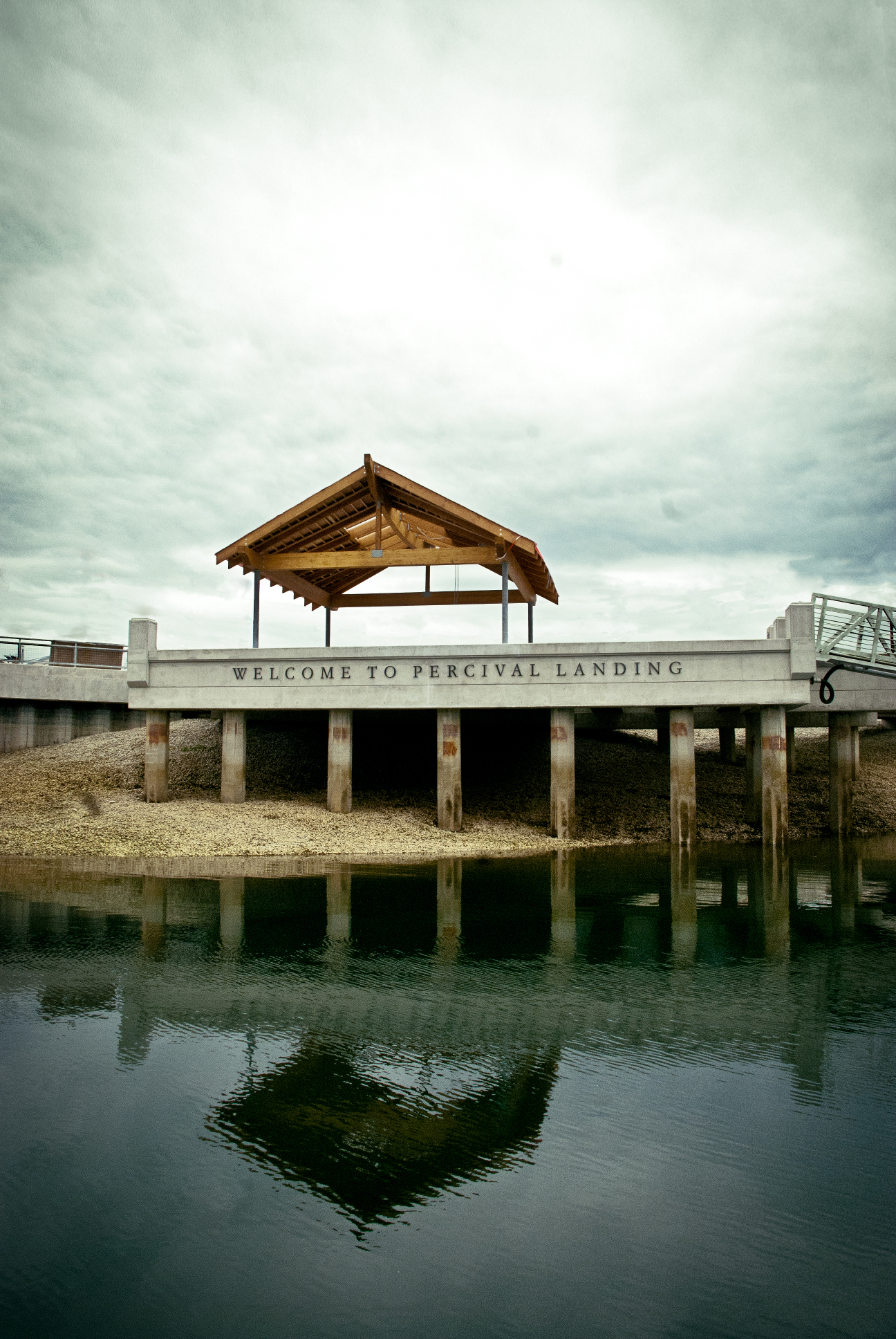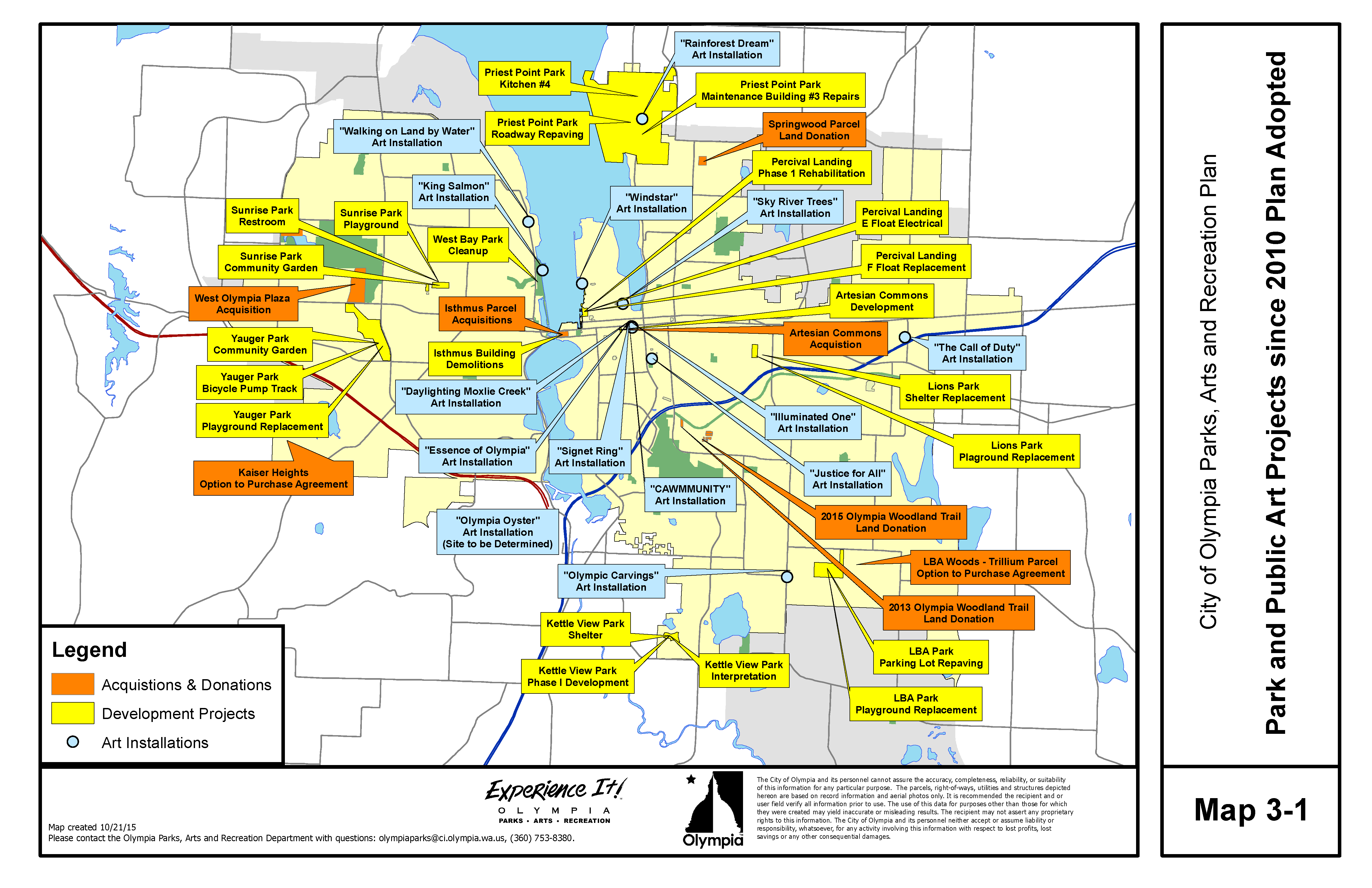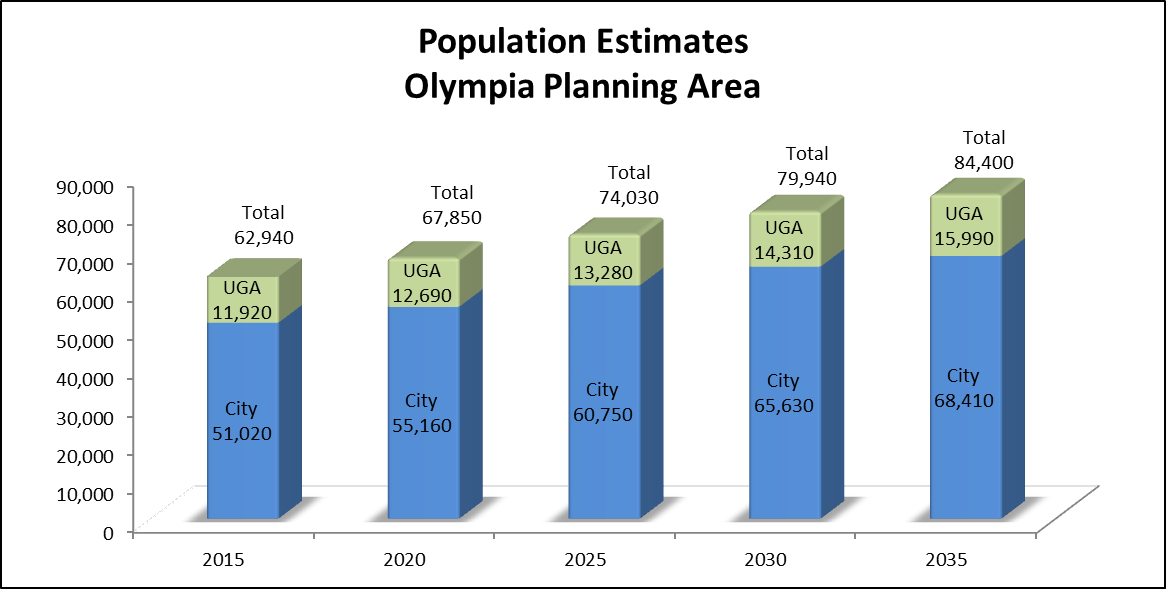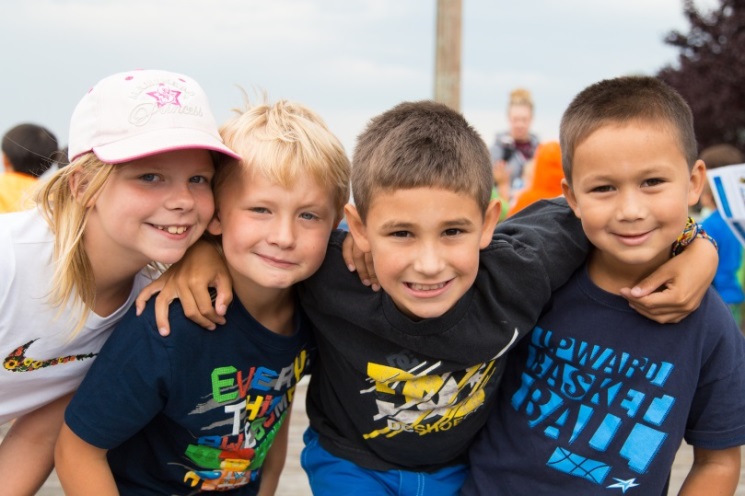Chapter 3 Report on the Last Plan
As we go forward, we build on the past. The last six years have brought many changes to our programs and services based on the blueprint presented in the 2010 Parks, Arts & Recreation Plan, City budgets, and community need.
Park Facilities Constructed Since 2010 Plan Adopted
Since the last plan was written, the following park facilities have been constructed:
• Lions Park Playground (2010)
• Percival Landing Plinths (2010)
• Percival Landing Reconstruction Phase 1 (2011)
• Kettle View Park Phase 1 (2011)
• Sunrise Park Restroom (2011)
• LBA Park Playground (2011)
• Yauger Park Playground (2011)
• Yauger Park Community Garden (2011)
• Sunrise Park Community Garden (2012)
• Lions Park Shelter (2012)
• Kettle View Park Shelter (2013)
• Artesian Commons Phase 1 (2014)
• Yauger Park Pump Track (2015)
• Sunrise Park Playground (2015)
• Percival Landing E Float Electrical (2015)
• Percival Landing F Float Replacement (2015)
• Priest Point Park Kitchen Shelter 4 (2015)

Percival Landing Reconstruction Phase 1
Public Art Pieces added to Olympia’s Collection Since 2010 Plan Adopted
|
Title |
Location |
Artist |
Year Acquired |
|---|---|---|---|
|
Olympic Carvings |
Boulevard/Log Cabin Roundabout |
Steve Jensen |
2010 |
|
CAWWMMUNITY |
Olympia City Hall |
Judith Gebhard Smith |
2011 |
|
Daylighting Moxlie Creek |
Olympia City Hall |
Mimi Williams |
2011 |
|
Essence of Olympia |
Olympia City Hall |
Shelley Carr |
2011 |
|
Signet Ring |
Olympia City Hall |
Tom Anderson |
2011 |
|
The Call of Duty |
Olympia Fire Station 4 |
Haiying Wu |
2012 |
|
Justice for All |
Lee Creighton Justice Center |
John Vanek |
2012 |
|
King Salmon |
West Bay Park |
Dan Klennert |
2012 |
|
Sky River Trees |
Hands On Children’s Museum |
Koryn Rolstad |
2012 |
|
Rainforest Dream |
Priest Point Park |
Leo E. Osborne |
2013 |
|
Windstar |
Port Plaza |
Ross Matteson |
2013 |
|
Walking on Land by Water |
West Bay Drive |
Carolyn Law and Lucia Perillo |
2014 |
|
Illuminated One |
City Hall |
Leo E. Osborne |
2014 |
|
Olympia Oyster |
TBD (Plinth Project People’s Choice) |
Colleen R. Cotey |
2015 |
 View Park and Public Art Projects since 2010 Plan Adopted.
View Park and Public Art Projects since 2010 Plan Adopted.
Grants and Donations Received Since 2010 Plan Adopted
Since the last plan was adopted in 2010, the Department has been able to augment traditional funding sources by securing over $7.9 million in grants and donations. Two generous citizens also donated land to the City for future park sites, totaling approximately four acres.
|
Monetary Grants/Donations |
|||
|
Date |
Project |
Agency |
Amount |
|
2010-2015 |
Arts Walk Sponsorship |
Heritage Bank & WSECU |
$12,000 |
|
2010-2015 |
Recreation Program Scholarships |
Community Donations |
$14,047 |
|
2010 |
Percival Landing Rehabilitation |
State Legislature |
$3,000,000 |
|
2010 |
Percival Landing Rehabilitation |
Housing and Urban Development |
$1,071,400 |
|
2010 |
Percival Landing Rehabilitation |
Washington State Heritage Capital Project Fund |
$555,660 |
|
2010 |
Percival Landing Rehabilitation |
Aquatic Lands Enhancement Account (RCO) |
$164,075 |
|
2011 |
Percival Landing Rehabilitation |
Citizens - Railing Project |
$32,600 |
|
2011 |
Park Stewardship – Volunteer Tools |
REI |
$10,000 |
|
2012 |
Isthmus Property Acquisition |
Thurston County Conservation Futures |
$600,000 |
|
2012 |
Olympia Woodland Trail Phase IV Study |
Washington Dept. of Transportation via Thurston Regional Planning Council |
$65,000 |
|
2012 |
Park Stewardship Interpretive kiosks |
REI |
15,000 |
|
2013 |
Isthmus Property Development |
Olympia Capitol Park Foundation |
$100,000 |
|
2013 |
Park Stewardship – Volunteer Trailer & Camping Equipment |
REI |
$10,000 |
|
2014 |
Isthmus Property Development |
Community Development Block Grant |
$250,000 |
|
2014 |
Percival Landing F Float |
Washington State Parks |
$308,874 |
|
2014 |
Yauger Park Pump Track |
REI |
$5,000 |
|
2014 |
Yauger Park Pump Track |
Macy’s |
$449 |
|
2014 |
Olympia Woodland Trail “Hub Junction” project |
Federal Transportation Alternatives Program Grant via Thurston Regional Trails Council |
$50,000 |
|
2015 |
Percival Landing Bulkhead Replacement |
State Appropriation |
$921,500 |
|
2015 |
Stevens Field Synthetic Turf |
Washington Recreation and Conservation Office |
$193,223 |
|
2015 |
Yauger Park Pump Track |
Nisqually Indian Tribe/PARC Foundation |
$5,000 |
|
2015 |
Park Stewardship Trail Stewardship Program |
REI |
$8,000 |
|
2015 |
Park Stewardship Volunteer Appreciation sponsorship |
Washington State Employees Credit Union |
$400 |
|
2010-2015 |
Park Stewardship volunteer hours (6,500 average annually) |
N/A |
$585,000 |
|
|
|
TOTAL |
$7,977,228.00 |
|
|
|
|
|
|
Land Donations |
|||
|
2013 |
Olympia Woodland Trail Addition |
Private Citizen |
.89 acres |
|
2015 |
Springwood parcel (formerly Zabels) |
Private Citizen |
3.19 acres |
|
2015 |
Olympia Woodland Trail Addition |
Private Citizen |
2.39 acres |
|
|
|
TOTAL |
6.47 acres |
These funds and land donations will benefit the citizens of Olympia though enhanced amenities, greater access to nature, and a more beautiful urban landscape.
Changes in Programs and Services since 2010 Plan Adopted
Extensive changes have been made in activities and services since 2010. The most significant are listed below:
Activities:
• Percival Plinth Project (sculptural exhibition on Percival Landing)
• Community gardens
• Kids Canopy Climb tree-canopy environmental education climbing adventure
• Environmental stewardship elements integrated into Outdoor Adventure programming
• Increased offerings of youth camps
• Adopt-A-Park Program
• Park Stewards Program
• Junior Ranger Program
• Annual Backyard Campout in Priest Point Park
• Nature Hikes
• Artesian Commons activities and events
• Youth and adult ultimate Frisbee league
• “Smaller Ballers” youth sports program
Services:
• On-line map of all public art: public art
• Pesticide Free Parks initiative in six neighborhood parks
• Safe and Secure Parks initiative
• Monthly department e-newsletter
• Use of social media and on-line public input forums
• Volunteer Power Tool Program
• Harbor House and Priest Point Park Shelter #4 available for rent
Setting the Stage for the Future: Planning Projects
A variety of planning efforts have set the stage for projects already in the works and those slated for completion during this planning horizon.
Some significant planning efforts since 2010 have included:
• Percival Landing Condition Assessment Report (2014)
• Community Park Site Suitability Study (2014)
• Olympia Woodland Trail Phase 4 Alternatives Analysis Study (2014)
• Heritage Park Fountain Evaluation (2014)
• Olympia Comprehensive Plan (2014)
• Municipal Art Plan (2015)
• West Bay Environmental Restoration Assessment (2015)
• Downtown Strategy (underway)
Challenges: Balancing Priorities in a Changing Community
Those who live here treasure Olympia’s location at the southern end of Puget Sound. We value our relationship to our natural environment. We cherish our backyard – forested ravines, wetlands, and evergreen landscape. Our environment is rich in beauty and diversity. In addition to our wonderful people, our environment enhances our quality of life in Olympia.
Our world continues to change at a record pace. Change offers both challenge and opportunity. Some of the major challenges that will likely have a major impact on OPARD services in the coming years are described below.
1. Public Needs to be Safe and Secure in Parks and Facilities
The past several years have seen an increase of unwanted and illegal behavior in Olympia’s parks. Illegal drug use, vandalism, alcohol consumption, unauthorized camping and violent behavior are issues in several of our parks, particularly in the downtown core, making for an unsafe and unwelcome environment.
Significance for the Plan
Increased resources will be added to improve park and facility security. These may include security guards, security cameras, increased ranger patrols, and increased park programming.
OPARD will continue to work closely with the Olympia Police Department, Downtown Ambassador Program, Artesian Leadership Committee, Olympia Downtown Association and other community groups to foster positive behavior in Olympia’s parks.
2. Public Demand for New Parks Exceeds Resources
Many of the most desired new parks projects in Olympia will cost tens of millions of dollars each. These “mega projects” include rebuilding the remaining phases of Percival Landing, completing the final phases of the Olympia Woodland Trail, acquiring and demolishing the empty nine-story Capitol Center building on the Isthmus, acquiring the LBA Woods open space adjacent to LBA Park, developing West Bay Park and Trail and acquiring and developing an athletic field complex. When surveyed about which one of these projects was the most important, no single project rose to the top.
 View Figure 3.1 Random Sample Survey Results – Prioritization of Large Projects
View Figure 3.1 Random Sample Survey Results – Prioritization of Large Projects
Source: City of Olympia Resident Priorities for Parks, Arts & Recreation, April, 2015, p. 27.
Significance for the Plan
Even with projected revenue from the recently passed Olympia Metropolitan Park District, the City’s sources of revenue for parks are insufficient to implement all of these “mega projects” in the near-term. A phased approach will be necessary to achieve these community goals.
3. Population Growth Creating Demand for New Park Land
Today Olympia’s population is estimated at 51,020. Outside the city limits, but within Olympia’s Urban Growth Area (UGA), reside another 11,920 people. The total combined population in 2015 is estimated to be 62,940. During the next twenty years, the population of Olympia and its UGA are expected to grow to 84,400, an increase of over 21,000 people. Figure 3.2 illustrates the population forecast to 2035.
 View Figure 3.2 Population Esitmates Olympia Planning Area
View Figure 3.2 Population Esitmates Olympia Planning Area
Source: Thurston Regional Planning Council: Small Area Population Estimates and Population and Employment Forecast Work Program, 2014.
Population is a key factor used to project needs for future parks, arts and recreation programs and facilities. The planning area for this study includes Olympia’s city limits and Urban Growth Area. The purpose of including the growth areas is to plan for areas that are anticipated to be annexed into the City.
Significance for the Plan
Increases in population will drive the demand for additional facilities, programs, maintenance and services.
With increasing growth, the availability of land for parks, open space, and trails will decrease.
A significant portion of the new growth in the region is occurring outside the Olympia city limits. This regional growth will continue to create demand for city parks and services.
As density increases and more residents are living in households with very small or no yards, there is a greater reliance on parks to provide for recreational activities that were once done at home. This includes community garden space, off-leash dog areas, open grassy areas and urban forest.
4. Percival Landing Needs to be Replaced
Percival Landing, built in three phases from 1977 thru 1988, is deteriorating. In 2011, the City replaced about 700 feet (of approximately 5,000 feet of existing boardwalk) leaving over 4,000 feet of original wooden boardwalk remaining. Annual inspections and follow-up repairs have served to keep the Landing open and safe for the past several years. Marine engineers estimate that the cost of temporary repairs will grow exponentially over time.
Significance for the Plan
Percival Landing is one of Olympia’s signature attractions and most popular parks. It provides public access to the waterfront. It draws thousands of visitors and residents annually and is a significant economic draw for downtown. Replacing Percival Landing is expensive and will need to be implemented in phases as funding allows. (See p. 37 for more information on Percival Landing).
5. Invasive Species Threaten Olympia’s Open Spaces
Olympia is fortunate to have a park inventory that includes over 800 acres of open space, natural areas set aside to protect the special natural character of Olympia’s landscape. From the mature forests and streams of Priest Point Park and Watershed Park, to the wetland and riparian habitat at Grass Lake and Mission Creek Nature Parks, Olympia has several special places set aside for humans and wildlife alike. The habitat value of these areas is increasingly threatened by invasive species such as English ivy, Himalayan blackberry, Scotch broom, and knotweed. These non-native species choke out native plants, degrading the habitat value of these open space areas. This may eventually prevent healthy forest development and impair the ability of these areas to protect stream and wetlands
Significance for the Plan
Despite hundreds of volunteers contributing thousands of hours annually eradicating invasive species through the Parks Stewardship Program, this problem appears to be getting worse each year rather than better. Without greater resources to tackle this problem, the habitat value of Olympia’s open space areas will continue to degrade.
Percival Landing Boardwalk
Conclusion
Olympia and its residents have changed since 2010 when the last Parks, Arts, and Recreation Plan was written. From an increase in population, to increasing focus on park safety and security, these changes have great significance to the programs and facilities that OPARD will provide during the next twenty years. A creative approach will be necessary to address these challenges. In the following chapters, you will read about a vision for adapting to these changes.

Kids at Summer Camp


